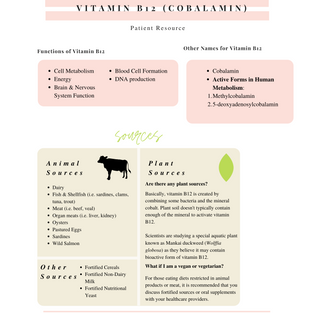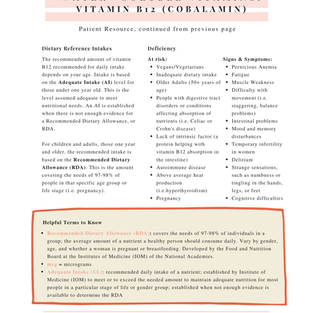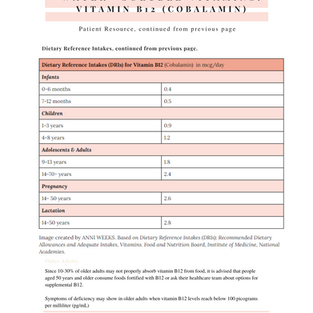Vitamin B12 (Cobalamin)
- Anni Weeks, NDTR

- Jan 26, 2021
- 8 min read
Everything you need to know about Vitamin B12 (a.k.a. Cobalamin), from nutrition expert Annika Weeks, NDTR.

What is Vitamin B12?
Do you like getting things for free? So do we!
Click here your FREE 4-page download😍👇🏼✨

Vitamin B12 is a water-soluble nutrient. It is incredibly important to many of the body’s essential functions.
Does Vitamin B12 go by other names?
Cobalamin is another name for vitamin B12. It gets its name from the mineral cobalt since vitamins with B12 activity contain the mineral. The compounds are collectively called “cobalamins”.
Vitamin B12 also has two main active forms that participate in human metabolism:
Methylcobalamin
5-deoxyadenosylcobalamin
What does the body use Vitamin B12 for?
The body uses vitamin B12 for many important functions, including:
Cell metabolism
Energy
Brain and nervous system function
Blood cell formation
DNA production
Recommended Amounts

Dietary Reference Intakes (DRIs)
The recommended amount of vitamin B12 recommended for daily intake depends on your age. Intake is based on the Adequate Intake (AI) level for those under one year old. This is the level assumed adequate to meet nutritional needs. An AI is established when there is not enough evidence for a Recommended Dietary Allowance, or RDA.
For children and adults, those one year and older, the recommended intake is based on the Recommended Dietary Allowance (RDA). This is the amount covering the needs of 97-98% of people in that specific age group or life stage (i.e. pregnancy).
Helpful terms to know
Recommended Dietary Allowance (RDA): covers the needs of 97-98% of individuals in a group; the average amount of a nutrient a healthy person should consume daily. Vary by gender, age, and whether a woman is pregnant or breastfeeding. Developed by the Food and Nutrition Board at the Institutes of Medicine (IOM) of the National Academies.
mcg = micrograms
Adequate Intake (AI): recommended daily intake of a nutrient; established by Institute of Medicine (IOM) to meet or to exceed the needed amount to maintain adequate nutrition for most people in a particular stage of life or gender group; established when not enough evidence is available to determine the RDA

Older Adults

Since 10-30% of older adults may not properly absorb vitamin B12 from food, it is advised that people aged 50 years and older consume foods fortified with B12 or ask their healthcare team about options for supplemental B12.
Symptoms of deficiency may show in older adults when vitamin B12 levels reach below 100 picograms per milliliter (pg/mL). Find out how to test your vitamin B12 status by clicking here.
Deficiency
Who is at risk for a folate deficiency?
Deficiency of vitamin B12 is rare, however certain conditions or lifestyle choices can put you at increased risk:
Inadequate dietary intake
Vegetarian or Vegan diet (plant foods don’t contain vitamin B12)
Older adults
People with digestive tract conditions (affects absorption of nutrients, i.e. Celiac or Crohn’s disease)
Lack of intrinsic factor (protein helping to absorb B12 in the intestine)
Autoimmune disease
Above average heat production (i.e. with hyperthyroidism)
Pregnancy

People eating a vegetarian or vegan diet may be at advanced risk for vitamin B12 deficiency.
Signs & Symptoms
Common signs of a untreated vitamin B12 deficiency include:
Anemia
Fatigue
Muscle weakness
Difficulty with movement (i.e. walking, staggering, balance problems)
Intestinal problems
Nerve damage
Mood disturbances
Temporary infertility in women
Sudden/severe confusion (delirium)
Strange sensations (i.e. numbness, tingling) in the hands, legs, or feet
Cognitive difficulties (i.e. difficulty thinking or reasoning)
If left untreated, deficiency can even lead to permanent nerve damage deteriorating brain function, and memory loss.
Pernicious anemia

Pernicious anemia is a condition that occurs when there is a reduction of red blood cells. The intestine in normal conditions will absorb vitamin B12 and use it to help produce red blood cells. When the intestines can’t absorb vitamin B12, or there isn’t enough intake, pernicious anemia can occur.
Symptoms can be tricky because they don’t typically exhibit in people under 30 years of age. The average age of diagnosis is 60 years old, and this may be due to the fact that B12 deficiency is known to be more common in older adults.
Symptoms of pernicious anemia can include:
Digestive problems (i.e. diarrhea, constipation)
Exhaustion
Loss of appetite
Pale skin
Inflammation of the tongue or bleeding gums
Treatments of pernicious anemia typically require weekly injections of vitamin B12. This bypasses the intestinal absorption, since the anemia is actually indicative of a severe stage of autoimmune inflammation.
In this stage, pernicious anemia results in destruction of the stomach and intestinal cells. This causes decreased ability of the digestive tract to produce what is required to extract vitamin B12 from ingested food.
Toxicity
A toxic level or upper intake level (UL) for vitamin B12 has not yet been determined. ULs are established when the level of intake of a vitamin reaches a harmful level.
Even with no UL established, it is recommended for consumers to stay within the DRI appropriate for their age and life stage.
If there isn’t an upper limit of Vitamin B12, can high levels be dangerous?
People with obesity or people who eat a lot of meat may have higher than average levels of vitamin B12. Since B12 is such an essential vitamin, higher levels may seem like a good thing.
However, obesity (measured by rising BMI) is associated with lowering levels of vitamin B12.
In other words, as a study on pediatric obesity and vitamin B12 status put so accurately :
“The dietary habits of obese...may comprise higher quantities of carbohydrates, fat and lower amounts of animal protein containing vitamin B12.”
What do higher levels of vitamin B12 indicate?
Other than high intake of meat or obesity, high vitamin B12 levels can mean the following:
Liver disease or damage (i.e. cirrhosis or hepatitis)
Myeloproliferative disorders/cancers (i.e. polycythemia vera, chronic myelogenous leukemia)
How To Determine Cobalamin (Vitamin B12) Levels

Vitamin B12 status is assessed through a blood draw (also called lab work) or a take-home urine test. Levels can be determined through the urine because vitamin B12 is a water-soluble nutrient. This means that it is excreted through the urine.
These tests often measure several things, including:
Overall vitamin B12
Normal: 160-950 picograms/milliliter (pg/mL) or 118-701 picomoles/liter (pmol/L)
Methlymalonic acid (MMA) and holotranscobalamin (holoTC)
Represent active vitamin B12
Homocysteine
Can indicate folate status (Improper folate intake can mask a B12 deficiency; read more about proper supplementation here)
These tests should be run under direct medical supervision. Ask your doctor and dietitian for more information.
Due to some of the limitations of these tests, multiple exams and tests should be performed in order to establish a true deficiency. Home-testing kits are available, but I do not recommend them, unless directed so by a licensed medical expert. They are often expensive and less accurate than the tests performed by a doctor or registered dietitian.
Common Reasons for Testing
The following are common conditions and concerning symptoms for which a vitamin B12 test is ordered:
Delirium
Loss of brain function (dementia)
Dementia due to metabolic causes (i.e. hormonal disorders, toxin exposure, hypoglycemia, alcohol use, etc.)
Abnormal nerve function (a.k.a. Nerve abnormalities or neuropathy)
Who should be tested for vitamin B12 status?
Those who are at risk for a deficiency should be tested. Healthcare providers may find it necessary to test the following populations:
Children
People with diabetes
People who have had gastric bypass surgery
Breastfeeding mothers in an at risk group
Medication Interactions
The following medications can affect the body’s vitamin B12 levels:
chloramphenicol/Chloromycetin
Proton pump inhibitors (i.e. Prilosec, Prevacid)
H2 receptor blockers (i.e. Tagamet, Pepcid, Zantac)
Metformin (for diabetes/insulin resistance)
Sources of Vitamin B12

Vitamin B12 is found primarily in animal sources. However, it’s true origin is microbial (a.k.a. Microbes or bacteria). These bacteria are found in the soil as well as in the human or animal gut. However, cobalt is only found in trace (small) amounts in plants and the bacteria must come in contact with cobalt to produce active vitamin B12 (cobalamin) compounds.
Researchers are examining a special kind of green algae aquatic plant called Wolffia globosa (Mankai), more commonly known as Mankai Duckweed. This plant-based protein may contain a bioactive vitamin B12 that is well absorbed by humans. Read more about their efforts in this study.
How stable is vitamin B12?
A recent study suggested that vitamin B12 does not store well long-term, experiencing an almost 50% decrease in the concentration upon storage. Another study supports these findings, especially when applied to food packaging.
Researchers found the following:
Well-packaged flours were stable for up to 6 months
Vitamin B9 and B12 were the most affected by packaging
Low-quality packaging affected microbial quality and vitamins experienced changes
In other words, packaging is important when it comes to the stability of vitamin B12. Well-packaged and properly stored flours have a better chance of keeping their vitamin quality, and ultimately of benefitting microbial quality (the microbiome) of your intestine.
Similarly to folate, researchers are investigating different methods of storage and their potential to enhance stability. One promising alternative is a spray chilling encapsulation technique, which protects the nutrient without the need for other variables to be controlled. It also is a low cost option, which could make treatment more affordable and accessible in the future.
Supplementation & Treatment with Vitamin B12
Uses & Treatment
Vitamin B12 may be prescribed by your doctor or dietitian for the following conditions:
Tingling in the extremities (i.e. hands, feet)
Balance problems
Abnormal heartbeat
Confusion or dementia
Weakness
Loss of appetite
Pernicious anemia (reduction of red blood cells)

Correcting a Vitamin B12 Deficiency
There are three main ways to correct or protect against a vitamin B12 deficiency if you are at risk or have received a diagnosis of deficiency:
Weekly vitamin B12 shots: Ask your doctor or dietitian about vitamin B12 shots as a treatment option.
Daily vitamin B12 pills: Your healthcare provider may prescribe B12 pills at a higher-dose as part of your daily regimen if you are at risk.
Supplementing with a Standard Multivitamin: Most people who don’t fall into at risk categories can safely meet their vitamin B12 needs through a combination of diet and supplementing with a standard multivitamin.
I’ve recommended some of my favorite multivitamins at the end of the article Ask Anni | What Do I Need to Know About MTHFR, where I talk about supplementing safely with folate and how to avoid masking a vitamin B12 deficiency.
Other options include new technologies like nasal sprays.
The Bottom Line on B12
Vitamin B12 comes mainly from fortified sources and animal products, but promising new sources may help extract it from plants. At risk for deficiency includes those with autoimmune, digestive, or metabolic conditions. Pregnant and lactating women also have elevated needs. Those eating a vegan or vegetarian diet should talk to their healthcare providers and find an appropriate way to discuss and assess cobalamin status. There are many options for treatment, and they range from daily to weekly regimens.
FREE Patient Resources
Do you like getting things for free? So do we!
Click here your FREE 4-page download😍👇🏼✨
Products for Professionals
Buy Now!👇🏼
Frustrated trying to remember the nutrient facts? It's hard to keep track of all the vitamins!
With this easy to navigate 6-page guide, never forget the facts again!
With purchase, a high quality PDF file will be available for download. Turn it into posters, handouts, and even more.
It's simply the best way to avoid stress and brush up on your B-vitamin before meeting with a patient!
Related Posts
References
Baltaci D, Deler MH, Turker Y, Ermis F, Iliev D, Velioglu U. Evaluation of serum Vitamin B12 level and related nutritional status among apparently healthy obese female individuals. Niger J Clin Pract. 2017;20(1).
Hart J. Eat Pretty. Chronicle Books. 2014. ISBN 978-1-4521-2366-0.
Harvard Health Publishing Staff. Vitamin B12 deficiency can be sneaky, harmful. Harvard University. 2020.
Health Library. Vitamin B12 level. Icahn School of Medicine at Mount Sinai. 2021.
Linus Pauling Institute, Micronutrient Information Center. Vitamin B12. Oregon State University. 2021.
Mayo Clinic Staff. Vitamin B-12. Mayo Foundation for Medical Education and Research. 2021.
Obeid R, Heil SG, Verhoeven MMA, van den Heuvel EGHM, de Groot LCPGM, Eussen SJPM. Vitamin B12 Intake From Animal Foods, Biomarkers, and Health Aspects. Front Nutr. 2019;6:93. Published 2019 Jun 28. doi:10.3389/fnut.2019.00093
Office of Dietary Supplements. Nutrient Recommendations: Dietary Reference Intakes (DRI). National Institutes of Health. 2021.
Office of Dietary Supplements. Vitamin B12. National Institutes of Health. 2021.
Semeco A. Top 12 Foods That Are High in Vitamin B12. Healthline. 2020.
Watanabe F, Bito T. Vitamin B12 sources and microbial interaction. Exp Biol Med (Maywood). 2018 Jan;243(2):148-158. doi: 10.1177/1535370217746612. Epub 2017 Dec 7. PMID: 29216732; PMCID: PMC5788147.













Comments